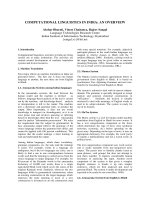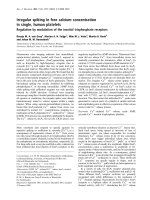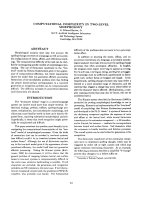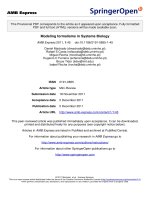Báo cáo y học: "Computational models in systems biology" pot
Bạn đang xem bản rút gọn của tài liệu. Xem và tải ngay bản đầy đủ của tài liệu tại đây (55.9 KB, 3 trang )
Genome
BBiioollooggyy
2008,
99::
328
Meeting report
CCoommppuuttaattiioonnaall mmooddeellss iinn ssyysstteemmss bbiioollooggyy
Laurence Loewe* and Jane Hillston
†
Addresses: *Centre for Systems Biology at Edinburgh, School of Biological Sciences, The University of Edinburgh, Kings Buildings, Mayfield
Road, Edinburgh EH9 3JU, Scotland, UK.
†
Laboratory for the Foundations of Computer Science, School of Informatics, The University of
Edinburgh, Informatics Forum, 10 Crichton Street, Edinburgh EH8 9AB, Scotland, UK.
Correspondence: Laurence Loewe. Email:
Published: 10 December 2008
Genome
BBiioollooggyy
2008,
99::
328 (doi:10.1186/gb-2008-9-12-328)
The electronic version of this article is the complete one and can be
found online at />© 2008 BioMed Central Ltd
A report of the 6th International Conference on Compu-
tational Methods in Systems Biology, Rostock, Germany,
12-15 October 2008.
One of the chief goals of systems biology is to build
mechanistic mathematical models of biological systems to
further the understanding of biological detail. Such models
often aim at predicting the outcome of potentially interest-
ing biological experiments, and if such predictions are con-
firmed by wet-lab observations, an important step forward is
made. How exactly such models are constructed and how
predictions are computed were at the core of a recent
conference on Computational Methods in Systems Biology
that brought 80 participants to Rostock, Germany (for con-
ference proceedings see volume 5307 of Lecture Notes in Bio-
informatics [ />A simplistic approach to model construction might be to
capture everything that is known about a system and
simulate it in supercomputers. While this is appropriate for
some systems, it is impossible or highly impracticable for
many others. This is mostly due to the complexity of bio-
logical systems, which demand simplification to make them
amenable to modeling. Such simplifications have to capture
the essence of the processes of interest, while neglecting as
many of the less important details as possible. Thus, one can
consider model building in systems biology as the art of
building caricatures of life: capture the essence, ignore the rest.
CCoonnssttrruuccttiinngg ssyysstteemmss bbiioollooggyy mmooddeellss
Two formalisms called process algebras and Petri nets offer
alternative ways of constructing computational systems
biology models. Both are concerned with how to specify
(mostly quantitative) models of molecular reaction networks
in an abstract way that is independent of particular mathe-
matical techniques of analysis. Access to techniques such as
differential equations or stochastic simulations is then
facilitated automatically by software tools that translate the
abstract model into a concrete model that is ready for
computation. The advantage of this approach is that one
needs to describe the model only once in order to access a
variety of analytical techniques, which reduces implemen-
tation time and errors.
Corrado Priami (COSBI, Trento University, Italy) gave an
overview of the development of the new BlenX programming
language, which is based on a process algebraic core, and
can be used for modeling biochemical reaction networks that
change their topology over evolutionary time. It aims to be
more accessible to biologists than process algebras and is
supported by a range of software tools. Process algebras rely
on abstract formal (textual) notations that describe a bio-
chemical network as a concurrent system, using approaches
that were first developed to describe communicating
processes in computer science (a concurrent system consists
of a number of entities all of which can act simultaneously).
The stochastic pi calculus is another process algebra widely
used for modeling cellular systems. Andrew Phillips (Micro-
soft Research, Cambridge, UK), described a visualizer he has
developed to facilitate the understanding of stochastic pi
calculus models. He has applied this to the modeling of actin
polymerization. Matthias John (University of Rostock,
Germany) presented the attributed pi calculus, an extension
of the pi calculus that is parameterized with a special lan-
guage for the definition of the characteristics of interest. In
this approach, developed by Uhrmacher’s group in Rostock,
‘attributes’ capture additional information about the entities
being represented and allow the simulation models derived
to be more faithful to biological reality. This approach can be
used to model the phototaxis of Euglena. Marek Kwiatkowski
(University of Edinburgh, UK) introduced the continuous pi
calculus, which he has been developing. It provides a means of
describing a biological system as a set of ordinary differential
equations and has been applied to a circadian clock.
One of us (JH) gave an overview of Bio-PEPA, a stochastic
process algebra newly developed by Hillston’s group that is
designed for analyzing biochemical networks using a wide
range of mathematical techniques. It has been applied to a
number of biochemical pathways, including cyclin
regulation in the cell cycle.
Like process algebras, Petri nets also describe a biochemical
network as a concurrent system, but primarily use graphical
diagrams (‘nets’) to represent it. They support the abstract
theory behind applied methods such as flux-balance analy-
sis, and feature particularly well developed structural
analysis techniques, which give insight into how the topology
of the network influences the behavior.
Michael Pedersen (University of Edinburgh, UK) introduced
compositional definitions of minimal flows in Petri nets and
applied them to examples in the Petri-net-based ‘Calculus of
Biochemical Systems’. Being able to carry out analyses in a
compositional way allows much larger models to be handled
efficiently. Annegret Wagler (University of Magdeburg, Ger-
many) presented a combinatorial approach to reconstruct all
possible Petri nets that could explain a given set of experi-
mental data. Such work is important as it underlies the
development of methods for understanding flows through
metabolic networks.
Nonlinear kinetic models are often excessively complex to
analyze and Hidde de Jong (INRIA, Grenoble, France)
presented one approach to make their qualitative analysis
easier. He described how on some occasions they can be
simplified to piecewise linear differential equation models.
This makes it much faster to compute an overview of all
possible outcomes, as linear differential equations are easy
to solve and a corresponding tool, the Genetic Network
Analyzer (GNA) [ is avail-
able online.
A method widely used in computational systems biology is
the stochastic simulation of molecular systems. Matthias
Jeschke (University of Rostock, Germany) has compared the
performance of various simulation algorithms and found
that the underlying data structures used to implement an
algorithm can have a substantial impact on computing time.
MMooddeell cchheecckkiinngg
Model checking is an approach that evaluates a logical
expression against a model that describes the behavior of the
system. It is used extensively to check the properties of
computer systems and is now being applied to systems
biology. In a biological context, model checking might seek
to answer the question: ‘In the model, will the concentration
of a given metabolite exceed a certain value within a certain
time?’ With the aim of exploring how model checking could
be used to estimate parameters in simulation models,
Aurélien Rizk (INRIA, Rocquencourt, France) presented a
logic language that replaces the usual yes/no satisfaction of a
condition with a measure of how close the model is to
satisfying the condition. Rizk then relies on optimization
algorithms to find sets of parameters that minimize the
distance of the model to the formal condition on the basis of
observed data and assumed algorithms. It performed well on
a MAP kinase (MAPK) signal transduction model with 22
unknowns (examples of unknowns include reaction rates).
In an independent study with the same objective, David
Gilbert (Brunel University, London, UK) also estimated
parameters in a MAPK signal transduction model. The
genetic algorithm Gilbert uses for optimization is not as fast
as the algorithms employed by Rizk, but could have other
benefits, such as being less affected by local optima. It is too
early to assess how these two approaches compare, or to
advise on which should be adopted for a particular problem.
Future work will have to show how they will compare with
established statistical methods for parameter estimation
such as maximum likelihood or Bayesian approaches.
MMooddeelliinngg iinn tthhrreeee ddiimmeennssiioonnss
Substantial advances were reported in building spatial
models of intracellular processes. Robert Murphy (Carnegie
Mellon University, Pittsburgh, USA) reviewed the work of
his group in developing automated methods for determining
the intracellular location of proteins tagged with green
fluorescent protein. Traditionally, this could only be done by
expert microscopic examination. Using image-recognition
and machine-learning techniques, it is now possible to
automate the task, while retaining a degree of certainty for
each identification. The accuracy of the automated system
can now match that of human experts if sufficient certainty
is demanded for a valid match. It is hoped that such work
will help with the automated construction of spatially more
explicit models of intracellular processes.
Such models might eventually be passed on to the
impressive E-Cell simulation machinery of Koichi Takahashi
(RIKEN, Yokohama, Japan), who presented a new, highly
efficient method for simulating Brownian dynamics in cells
and reviewed the spatial modeling approaches that are
supported by the E-Cell Project [].
PPrraaccttiiccaall aapppplliiccaattiioonnss
Good quantitative models have practical applications. Dieter
Oesterhelt (Max Plank Institute of Biochemistry, Martins-
ried, Germany) demonstrated the down-to-earth potential of
Genome
BBiioollooggyy
2008, Volume 9, Issue 12, Article 328 Loewe and Hillston 328.2
Genome
BBiioollooggyy
2008,
99::
328
models in systems biology using examples from halophilic
archaea, including a simple mechanism for regulating the
flagellar motor in a way that guarantees an optimal response
of the cell to light. He also presented a flux-balance analysis
model with about 700 reactions that is capable of predicting
growth rates in response to the addition of 16 amino acids to
the growth medium. Nicolas Le Novère (European Bioinfor-
matics Institute, Cambridge, UK) presented models of
neurological signaling at multiple scales, where lower scales
are used to build helpful abstractions at higher scales. Such
models are designed to contribute towards understanding
dopamine biochemistry and can generate up to 10 terabytes
of data for simulating 1 second in the life of a synapse.
At a simpler level, Carolyn Talcott (SRI International, Menlo
Park, USA) presented an abstract model of the central
pattern generator located in the buccal ganglia of the marine
mollusc Aplysia, a long-time model organism for neuro-
biology. Her simple model considered only a small number
of discrete levels of excitation for each neuron but was able
to faithfully reproduce the predicted behavior of a more
detailed continuous, ordinary differential equation model.
Thus, instead of the continuous-state-space approach of
differential equations, a logic-based discrete-state-space
description of the system is used. This is conceptually much
simpler.
The future is likely to see many more mechanistically under-
stood models of actual biological systems that rely on
computational methods in systems biology for their
construction. The conference showed that there is the poten-
tial to greatly enhance our understanding of life if theoretical
computer scientists, practical programmers, theoretical
biologists and experimental biologists work closely together
in order to develop the tools that are needed for constructing
and analyzing systems biological models.
AAcckknnoowwlleeddggeemmeennttss
LL’s attendance at the meeting was supported by the BBSRC through the
Centre for Systems Biology at Edinburgh (reference BB/D019621/1).
Genome
BBiioollooggyy
2008, Volume 9, Issue 12, Article 328 Loewe and Hillston 328.3
Genome
BBiioollooggyy
2008,
99::
328









